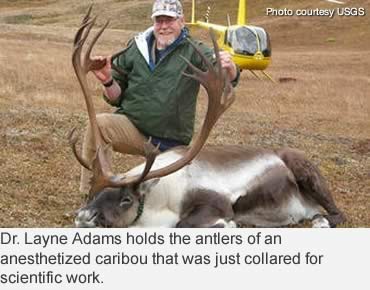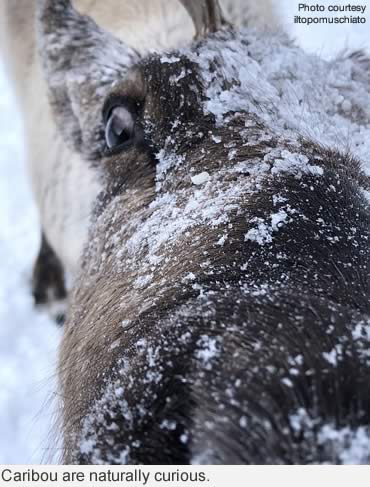By U.S. Geological Survey
Caribou, North America’s wild reindeer, have lives apart from their famous Christmas Eve role.
Photo: Early in winter a mama caribou teaches her calf how to dig for lichen. In early winter, snow is a few inches deep, but later will be three feet deep, and probably up to the calf’s belly.
To learn how the Arctic antler-bearers spend the other 364 days of the year, we’ve consulted USGS caribou and large mammal expert Dr. Layne Adams, who has studied caribou for more than 35 years. He says they are much more interesting creatures than their role of pulling Santa’s sleigh suggests.
A wildlife biologist, Dr. Adams has studied caribou, other hoofed animals and their predators in Denali National Park and elsewhere, helping land managers understand the best ways to manage them. At the USGS Alaska Science Center in Anchorage, Dr. Adams and others conduct a variety of earth- and ecological-science surveys to learn more about the biology behind the not-so mythical creatures.
 Here’s what Dr. Adams has to say.
Here’s what Dr. Adams has to say.
Why are reindeer sometimes called caribou and caribou sometimes called reindeer?
“Reindeer” and “caribou” are two common names for the same species Rangifer tarandus, which occurs throughout the circumpolar North. Reindeer is the common name for Rangifer in Europe and Asia, and caribou is the North American name. The name caribou is a French derivative of a Native American word that means snow-shoveler, because caribou paw through the snow to find food underneath.
Caribou and reindeer are members of the deer family, and are related to deer, moose and elk. They are the only deer species where both males and females grow antlers. Females and young males have antlers similar in size, but males older than 2 or 3 years have much larger antlers.
Caribou have been around for more than a million years.
Their ancestors lived at the same time as now-extinct woolly mammoths and saber-toothed cats. They are migratory, and we find them across northern North America from Alaska and the Canadian High Arctic islands, to the mountains and boreal forests of the Canadian southern provinces.
What are domesticated reindeer?
Reindeer were domesticated in northern Europe and Asia thousands of years ago, and were the basis of herding cultures. They are also found in Alaska and Canada. Around a century ago, 1,300 reindeer were imported from Siberia to Alaska to establish a herding economy among the Native people because caribou were scarce along Alaska’s northwest coast.
Reindeer herding expanded in Alaska and northern Canada and by the 1930s, some 600,000 domesticated reindeer were present in Alaska. But, during the Depression, the reindeer industry collapsed and shrunk to Alaska’s Seward Peninsula where it continues today. While the main purpose for domesticated reindeer has been to provide meat and hides to local people, reindeer are trained to pull sleds by some cultures.
What do they eat?
Caribou forage on a variety of plants. In winter, lichens are sought with shrubs and grass or sedges. On alpine and Arctic tundra ranges, they feed on terrestrial lichens called reindeer moss in the low-growing grasses and shrubs that make up tundra vegetation. In southern mountain or boreal forest ranges where caribou winter in deep snow, arboreal lichens growing on trees are the main caribou forage. During summer, they eat a wide variety of green grasses or sedges, growing shrubs, and small forbs or flowering plants.
Late-summer mushrooms are also an important food for caribou.
What do caribou do in fall and winter?
Some caribou herds migrate to their winter ranges, the timing dictated by changing day length and the onset of snowfall. Fall is also breeding season when mature bulls compete for opportunities to breed with females.
Arctic caribou migrate south to winter ranges along boreal forests or onto tundra winter ranges where terrestrial lichens are abundant. Larger caribou herds migrate 300 to 400 miles between winter ranges and their calving and summer ranges.
Smaller mountain herds migrate from higher mountains to lower elevation tundra and forest ranges, while small boreal forest populations are sedentary throughout the year. Once on their winter range, caribou remain there from early October to late April.
How do they thrive in such cold temperatures?
Caribou are well adapted to living in cold regions and thrive in areas where winter temperatures can reach 70 or 80 degrees below zero. These animals are well insulated with a dense haircoat made up of wooly underfur and hollow guard hair over their entire body (except the very tip of their nose). They also have large, wide hooves for walking and digging through snow.
 What do caribou do in the summer?
What do caribou do in the summer?
After females give birth, caribou gather in large groups to help them better avoid predators and to escape incredibly bothersome mosquitoes and parasitic flies that are so abundant in early summer. Different herds stay together in the high mountains and along the Alaskan seacoasts where winds and cooler temperatures help protect them from summer heat and pesky insects. By mid-summer when insect numbers decline, caribou herds scatter into smaller groups. During this important time before winter they feed on remaining green grasses and sedges, willow leaves and mushrooms to gain weight.
How big are calves?
We’ve weighed quite a few newborn calves in Denali, and on average they weigh about 17 pounds. Calves are born in May and early June throughout Alaska, and most calves being born in any herd within about a 10-day period.
Caribou cows produce one calf each year, and generally begin producing calves when they are 2 to 4 years old depending on their nutritional status. In small herds like the Denali Caribou Herd, calves are subject to intense predation by wolves and grizzly bears. Fewer than half survive beyond 2 weeks.
In large, migratory populations, early calf survival is much higher because the huge number of calves born during a brief interval overwhelms the predators’ ability to kill as many.
How big are adult caribou?
In Denali National Park, mature adult males average about 500 pounds but can weigh more than 600 pounds. Adult females are about half as big, averaging about 240 pounds. In large migratory herds, caribou are smaller, about 400 pounds for adult males and 200 pounds for adult females.
How many herds are in Alaska?
There are 32 caribou herds recognized in Alaska, with 7 large migratory populations from 15,000 to 260,000 animals. The herds currently total about 700,000 animals, which is about 97% the caribou in the State. The remaining 25 herds range from 30 to 3,500 animals each, adding another 20,000 caribou.
What eats caribou?
Grizzly bears and wolves are primary caribou predators. Grizzly bears are very effective at killing calves less than a couple weeks old, and also often kill older caribou. Wolves are predators of both calves and older caribou. Black bears, golden eagles, wolverine and coyotes are also predators, as are humans.
Caribou are a mainstay of local subsistence in Bush Alaska, and they are a sought-after by other Alaskan residents and sport hunters. On average, people harvest about 22,000 caribou each year in Alaska.
Predation affects the number of caribou in smaller, sedentary populations. Large, migratory herds can reduce the effects of predation due to their sheer number. They also are affected by the nutritional limitations of their ranges compounded by competition with their herd mates.
Caribou are vulnerable in deep snow
A main goal of my research has been to understand the interrelationships of caribou and wolves in Denali National Park. For caribou, an important factor is the amount of snow, and how many are killed by wolves. In years with less snow, caribou have expanses of wind-blown, snow-free land to seek their food, and they make it through winter in good shape. Without deep snow, they evade wolves across bare, frozen tundra. During such times, wolves primarily kill caribou that are old, injured, not in good shape, or just unlucky. During low snow years when caribou are more evasive, we’ve found wolf packs tend to be smaller.
The balance favors wolves when there is a lot of snow. Caribou have a hard time finding food. They have to dig through deep or crusted snow or seek food on high mountain ridges where there is little snow and little food. Caribou have a harder time escaping from wolves in deep snow, and sometimes wolves chase caribou into deep snow where they are vulnerable even if they are in good shape.
In heavy snow years, wolf packs tend to be bigger and some packs produce more pups. In contrast, our caribou research shows after severe winters, not only are young (2-4 years old) and very old cows less likely to breed, but calves born are lighter, grow more slowly, and are more likely to be killed by predators in the weeks after they are born.